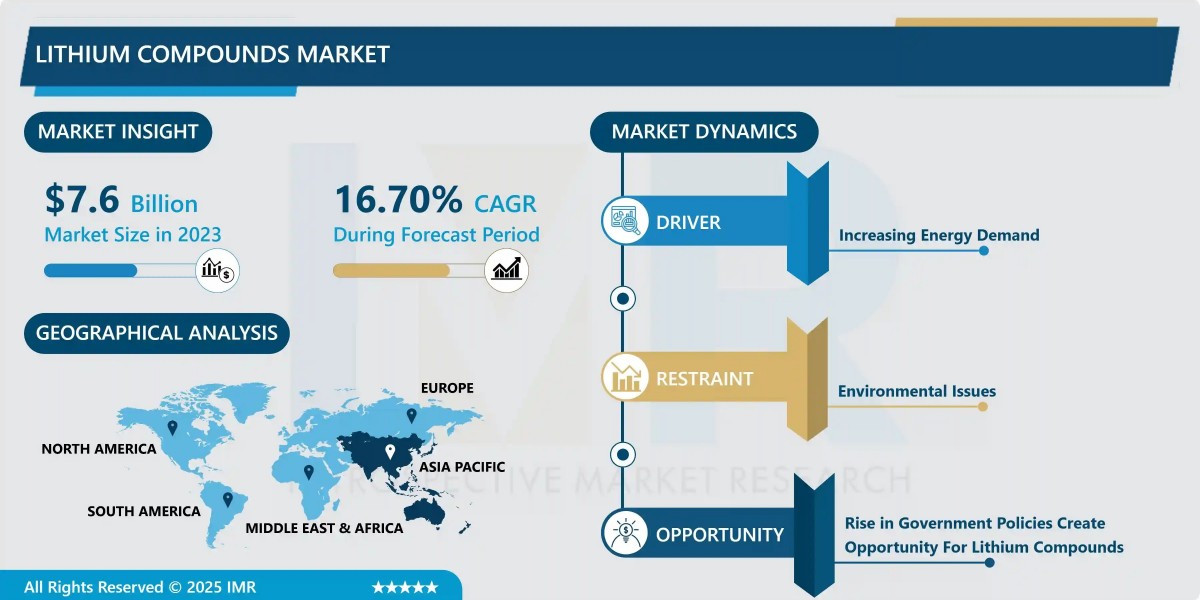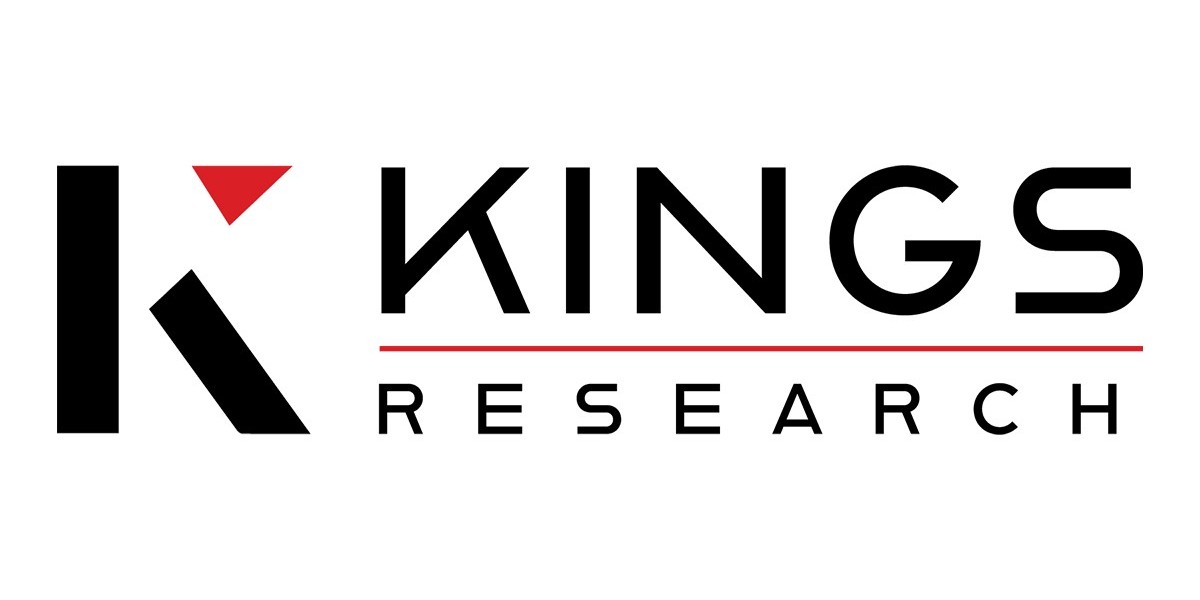Introspective Market Research, a pioneer in specialized market intelligence, today unveiled its comprehensive analysis of the global Lithium Compounds Market. The report confirms that lithium compounds—the backbone of the modern electric economy—are experiencing unprecedented demand growth. The market, which was valued at USD 7.6 Billion in 2023, is forecast to reach USD 30.51 Billion by 2032, marking a spectacular Compound Annual Growth Rate (CAGR) of 16.7% during the 2024–2032 forecast period. This explosive expansion is driven almost entirely by the relentless push toward electric vehicle (EV) mass adoption, global energy storage systems (ESS), and the strategic imperative of securing critical battery supply chains.
Quick Insights: Lithium Compounds Market (2024–2032)
Metric | Insight |
2023 Market Valuation | USD 7.6 Billion |
Projected 2032 Valuation | USD 30.51 Billion |
CAGR (2024-2032) | 16.7% |
Dominant Product Type | Lithium Carbonate (Primary battery precursor) |
Dominant Application | Batteries (Approx. 80% of current consumption) |
Leading End-User | Automotive (Driven by EV manufacturing) |
Key Market Driver | Increasing Energy Demand and EV Production |
Key Opportunity | Rise in Eco-Friendly Lithium Technology and Recycling |
Leading Regional Market | Asia-Pacific (Hub for battery and EV manufacturing) |
Segmentation Snapshot: The Core Chemical Components of the Energy Transition
The market is fundamentally segmented by the chemical form and its end-use application.
Market Segment | Leading Sub-Segment & Primary Use Case | Key Growth Catalyst |
By Product Type | Lithium Carbonate | Highest volume required for cathode material production, remains the lowest-cost precursor from brine extraction. |
By Application | Batteries | Rechargeable lithium-ion batteries across consumer, automotive, and grid storage sectors. |
By End-User | Automotive | Mandates and consumer shifts driving electric mobility. |
By Grade | Battery Grade | Strict purity requirements for high-performance battery cells. |
While Lithium Carbonate holds the volume dominance due to lower production costs and ease of extraction, Lithium Hydroxide is rapidly gaining traction. Its demand is propelled by the shift towards high-nickel cathodes, which increase the energy density and range of modern EV batteries. The competition between these two key compounds is shaping investment decisions in new refining capacity.
How are Sustainability and Geopolitics Reshaping the Lithium Supply Chain?
The unprecedented demand for lithium has triggered a global strategic shift, focusing on resource security and environmental responsibility:
1. Rise of Eco-Friendly Extraction (DLE): Increased attention is being paid to sustainable and environmentally friendly extraction techniques, such as Direct Lithium Extraction (DLE). DLE offers the potential for faster, cleaner, and more efficient resource utilization, addressing key environmental restraints associated with traditional mining and brine evaporation.
2. Focus on Battery Recycling: The concept of a circular economy is becoming critical. Companies are heavily investing in lithium recycling technologies to extract the metal from spent lithium-ion batteries. This not only mitigates future supply risks but also reduces the environmental footprint of mining new resources.
3. Government Policies: Favorable government regulations promoting renewable energy, electric vehicles, and local manufacturing (e.g., in North America and Europe) are creating significant opportunities, encouraging investment in domestic lithium production and processing capabilities to reduce dependence on Asia-Pacific sources.
Expert Insight: Navigating the Global Geopolitical Risks
"The sheer volatility in lithium compounds pricing over the last few years highlights that the global energy transition is entirely dependent on a highly concentrated and precarious supply chain," says Ms. Zara El-Dabbagh, Principal Consultant at Precedence Research. "The new strategic imperative for OEMs and battery manufacturers is vertical integration—securing long-term agreements with resource-rich nations and investing directly in next-generation processing facilities. Geopolitical factors, resource nationalism, and environmental compliance are no longer just risks; they are the primary cost of entry into the future automotive and energy market."
Competitive Dynamics and Recent Breakthroughs
The competitive environment is led by major players who control significant global production capacities, including Albemarle Corporation (USA), Ganfeng Lithium Co., Ltd. (China), Sociedad Química y Minera de Chile (SQM) (Chile), and Tianqi Lithium Corporation (China).
Recent breakthroughs focus on achieving Battery Grade purity at scale, particularly for Lithium Hydroxide. Companies are actively exploring and investing in projects outside the "Lithium Triangle" (Chile, Argentina, Bolivia) to diversify supply. For instance, top companies are making strategic investments in Australian hard rock mining and refining to ensure a steady supply of lithium hydroxide suitable for high-nickel cathode formulations. Furthermore, heavy R&D is being poured into advancing Solid-State Battery technology, which promises superior energy density and safety, and will require specialized, ultra-high purity compounds.
Challenges: The Environmental and Cost Juggernaut
The primary restraint on the market remains the Environmental Issues associated with traditional production processes. Brine evaporation requires vast tracts of land and water, while mineral extraction (from spodumene) requires significant energy input. Managing these environmental demands while maintaining production output, especially amidst volatile market prices, constitutes a persistent challenge. The high cost of building new refining and processing capacity further adds to the capital expenditure required across the entire value chain.
Case Study: The Secure Supply Chain Initiative
In 2024, a major European automotive original equipment manufacturer (OEM) entered a 10-year, multi-billion-dollar agreement with a leading South American lithium producer. This deal was contingent upon the producer adopting a Direct Lithium Extraction (DLE) process for a minimum of 40% of the contracted volume. The move secured a stable, long-term supply of Battery Grade Lithium Carbonate for the OEM’s new Gigafactory while simultaneously committing the producer to an eco-friendly, lower-water-consumption production process, highlighting how strategic supply security and sustainability are merging into unified investment decisions.
Call to Action
Master the Volatile Lithium Market: Download the Full Strategic Report For detailed profiles of all active players, production process analysis (Brine vs. Mineral vs. Recycling), and 2032 volume forecasts across all product types, download the complete market intelligence document today.
[Click Here to Request Sample Report] (Simulated Link: /reports/lithium-compounds-market/request-sample) [Schedule an Analyst Consultation] (Simulated Link: /contact/schedule-meeting)
About Introspective Market Research
Introspective Market Research (IMR) is a trusted provider of comprehensive market intelligence, offering in-depth insights into global industry trends, competitive landscapes, and growth opportunities. Our reports empower businesses to make informed, strategic decisions that accelerate growth and maximize value across diverse sectors.
Contact: Introspective Market Research
Phone: +91-74101-03736
Email: sales@introspectivemarketresearch.com
Website: https://introspectivemarketresearch.com/








